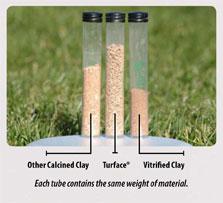The Turface Difference - Density

It is important to recognize that conditioners are added by volume rather than by weight. Even though the materials are sold by the ton and packaged in 50-pound bags, product is incorporated by the 5-gallon bucket, a wheelbarrow full, by the loader bucket or by the cubic yard. For this reason, it is important to consider the bulk density of a product. In other words, how much does it weigh per given unit?
This allows for the calculation of the cost of an item on a volumetric basis or cost per cubic yard. It is especially important when comparing products that have different weights. Infield conditioners have varying bulk densities. Vitrified clay and crushed aggregates are heavier than calcined clay – twice as heavy in some cases. So if it takes one bag of Turface to fill up a wheelbarrow, it will take two to three bags of vitrified clay or aggregate to fill the same wheelbarrow. Even though Turface calcined clay may be more expensive per pound, it ultimately costs less to fill the wheelbarrow.
As all infield conditioners are different, there are also many variances within the calcined clay category. Turface has a lower bulk density, up to 40% lighter in some cases, than other calcined clays. That means that you need to purchase 14 bags of a competitive calcined clay infield conditioner to equal the same usable material (volume) of 10 bags of Turface.
Product impurities and contaminants in all lesser quality conditioners can lead to higher bulk densities. Not only do impurities and contaminants increase the product weight (reducing the usable material per bag), they also negatively impact the performance of the product by reducing its porosity.
Only Turface provides the industry’s leading rate of water absorption for superior moisture management and ultimate value.